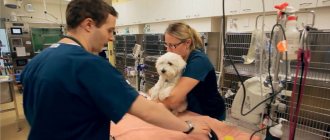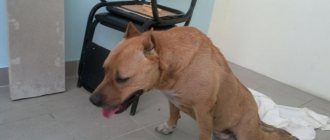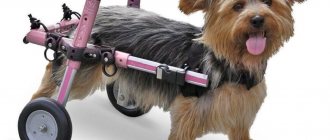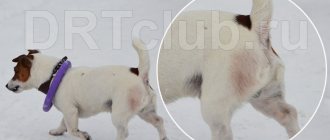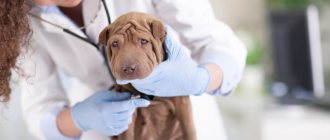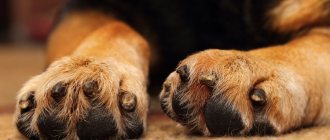Lameness in dogs is a change in gait resulting from dysfunction of the musculoskeletal system. She can limp on one leg, or maybe on two at once. This is not difficult to notice; usually the dog tucks its paw and hardly leans on it.
Sometimes the lameness is mild and it is even difficult for the owner to understand which leg his pet is limping on, but the change in gait is immediately noticeable. In this article we will figure out why this happens and what to do?
An important note: lameness does not equal pain. Walking problems are caused by other reasons besides pain.
Types of lameness
There are only four types of lameness. They are distinguished depending on what moment of the step causes pain or discomfort to the dog.
- Lameness of a leaning limb . It means that it is painful for the dog to lean on its paw.
- Lameness of a hanging limb - pain occurs when the dog lifts its paw and brings it forward. Standing on all four limbs does not cause pain.
- Intermittent claudication . When a dog limps on one leg or the other. This usually occurs during light running. During normal walking, the dog walks calmly. When owners notice that their pet is constantly limping on different legs, they think that the dog is faking it. But no, most often such lameness indicates vascular pathology. Namely, thrombosis and embolism of large vessels of the limb, which manifest themselves with rapid heartbeat during a light jog. When the heart rate is restored, the lameness disappears.
- Mixed . Mixed lameness indicates that the dog has difficulty both stepping on its paw and lifting and carrying it forward.
Additionally, lameness is also distinguished on the abduction side of the paw during leaning:
- Adduction is when a limb is pulled toward the body. Indicates soreness on the inside of the paw.
- Abduction - moving the paw to the side (outward from the body) during support.
Lame on one leg
A dog is limping on one leg due to a sprained tendon. A very common type of injury if the dog runs over rough or hilly terrain with significant changes in ground level and during large jumps during training. Pathophysiologically, ruptures occur in the bundles of fibrous tissue that make up the tendons. Accordingly, there is damage to blood vessels too. Small hematomas form at the site of injury, inflammatory fluid accumulates around them, and other signs of tendon inflammation—tendonitis—appear. The limb is painful, the animal begins to limp on the damaged paw
, you can clearly determine the location of the rupture. If the collateral ligaments are stretched, the pain will be reflected in the place of their fixation (punctum fixum) to the bones of the leg.
Degrees of lameness
There are three degrees of lameness depending on how much the limb is affected.
- Severe lameness is characterized by the dog's affected leg being unable to function at all. With leaning type lameness, the dog does not lean on it at all. Or with the type of suspended limb, it can only slightly move it forward. In this case, the movements of the diseased paw are limited to the maximum.
- With moderate lameness, the dog does not “use” its paw to its full potential. Supports or carries forward (depending on the type of lesion) to a limited extent.
- With a slight lameness, it is not always possible for an inexperienced eye to understand which limb is suffering. But it is clearly visible that the length and rhythm of the step have been changed. If the lameness is mild, it does not mean that you do not need to contact a veterinarian. The problem can be serious, despite the fact that it is not clearly expressed.
How to diagnose at home
If your pet's gait has changed, he is afraid to jump and has begun to behave with caution, you must first examine his paws for injuries. To do this, you should examine the limbs from all sides, and also check the animal’s reaction to touch.
If the examination does not produce results, you need to observe the dog moving through the wet sand. The impression of the diseased limb will turn inward and will be weaker than the others. Also, your stride length will become shorter than usual.
If these signs are present, the dog should be taken to the clinic for further diagnosis by a veterinarian. They will take an x-ray and may also prescribe a computed tomography scan to confirm the diagnosis.
Treatment directly depends on the root cause of the disease
Banal symptoms
Splinter
While walking, or even at home, the dog could “run into something.” A foreign object can become embedded in a paw pad or between toes and cause pain to your pet. In this case, it will be painful for the dog to step on its paw.
Wound
It could be as simple as a scratch, puncture wound, or even a bite from another animal. Sometimes this is a serious injury, in other cases it is a minor damage to the skin. The type of lameness and all associated symptoms will depend on the nature of the wound. Usually, even with small injuries, we see blood, but this is not the main sign of injury, and you should not rely only on it.
The dog is limping after an injection
It's not scary. Perhaps the injected drug itself is very painful, or perhaps if the injection was not done by an experienced veterinarian or the dog twitched during the process, then a nerve was hit. As a rule, such lameness develops already on the second or third day.
A bite of an insect
These crawling babies can overtake a dog both on the street and at home. If the dog suddenly limps, take a closer look, maybe he stepped on a wasp or a gadfly? This is usually not a big deal, but to avoid an allergic reaction, it is better to play it safe and take your pet to the vet.
Sticky snow
Of course, this is only relevant in the cold season, but one cannot help but say this. During a walk in winter, owners of especially fluffy dogs may notice that their pet is limping and generally does not run actively. There could be many other reasons, but examine the dog. It is quite possible that snowballs have stuck and rolled onto the fur that grows between the pads on the paws, making it difficult to walk normally. The solution is simple - cut off this excess hair.
Long claws
Not all dogs wear down their nails on their own; this usually applies to dwarf breeds. Such dogs need to periodically trim their claws on their own (with a special device - a nail clipper) or at an appointment with a veterinarian. If you start this process, the dog may begin to limp. And in severely advanced cases, the claw can grow into the pad of the finger. Then you cannot do without the help of a specialist.
Prevention
Any owner would like to protect their pet from all kinds of injuries, but daily walks and everyday situations can be associated with the risk of injury. Therefore, for prevention, the following rules should be observed.
To prevent lameness, the animal should be provided with a balanced diet and normal physical activity. It is necessary to examine the dog by a veterinarian every year; animals at risk - every 6 months. The latter include puppies, older dogs, representatives of giant and dwarf breeds.
The animal should not be allowed to play with significantly larger dogs, as this can result in serious injuries. After walks, you need to carefully examine your paws for splinters, wounds, cracks in the pads, and damage to the claws. Self-administration of painkillers before consulting a doctor is strictly prohibited. It is important to first determine the cause of lameness, and only then move on to eliminating the symptom itself.
Orthopedic pathologies
This is a separate large section of veterinary medicine, so we cannot reflect all aspects in the article. We have identified several main orthopedic pathologies that are most often found in dogs.
Hip dysplasia
A disease in which the hip joint is improperly formed and develops pathologically. The disease is most often caused by a genetic factor, but a predisposing factor can also be: unbalanced diet, environmental conditions, insufficient or, conversely, excessive physical activity.
As a rule, dogs of large and giant breeds, especially German shepherds, are susceptible to THD.
Also, there is a disease - dysplasia of the elbow joint, but most often there are lesions of a different kind. It is logical that when the hind limbs are affected with symptoms of lameness, fatigue and a general depressed state, the first thing we suspect is THD.
Bursitis
This is inflammation of the synovial bursa followed by accumulation of exudate in its cavity. The bursa itself is a “pocket” of connective tissue filled with fluid. It is located in places of special friction of the tendons, between the skin and the protruding part of the bone.
With bursitis, we observe a dense swelling that often encircles the limb in the joint area. If you touch this swelling, the dog will clearly experience pain, and you will also notice that the bursa is hotter than the rest of the pet’s body. It is painful and difficult for the dog to bend the affected paw, so it will limit its movements as much as possible.
Arthritis
This is an inflammatory process in the joint. It can develop due to many reasons, ranging from weakened immunity to age-related changes in the musculoskeletal system.
As with bursitis, we see swelling in the joint area, but not so obvious. In addition, a joint that is not lying “on the surface” can become inflamed, then the swelling will not be noticeable.
The owner must understand that the dog will not say that something hurts, and the pain with arthritis is very severe. Therefore, it is important to pay attention to the dog’s activity and its general condition.
Various types of deformations
This includes congenital pathologies of the structure of the musculoskeletal system, so-called congenital anomalies. They usually do not cause pain to the dog, but cause mechanical lameness.
Patella luxation
It sounds very unpleasant, but it is a common occurrence in small breed dogs. Moreover, this process often does not even cause pain to the pet. But this does not mean that the problem can be ignored!
You can suspect a luxated kneecap even when the dog is just standing. You need to pay attention to the placement of the limbs. With such a dislocation, the hind leg (or both) will resemble a crescent moon.
Anterior cruciate ligament rupture of the knee joint
The ligament mechanism is one of the most important components of a healthy joint. When the ligaments rupture, the integrity of the entire joint is compromised, which in the future can lead to irreversible destruction of the cartilage, and consequently the bone will be “exposed.”
This cannot be allowed. If you notice symptoms of a torn anterior cruciate ligament in your knee, see a specialist as soon as possible. Symptoms: the dog keeps its paw bent and suspended; when moving, it can sometimes step on it, but in a calm position it does not lean.
Osteosarcoma
This is the most terrible cause of lameness. Osteosarcoma is a new bone formation. To put it bluntly, bone cancer. With timely diagnosis, all necessary measures can be taken to prolong the life of the pet. But we must understand that often the end of this story is very sad. Usually there will be no other symptoms other than lameness at first.
Causes
There are several causes of the disease. First of all, arthrosis appears with age. Injuries and microtraumas, which can be repeated several times, are the cause of the disease. Large dogs and animals are especially vulnerable. In horses and dogs participating in sports competitions, the hock and carpal joints are damaged. Necrosis or infarction of the joint also occurs, the cause of which is overload and injury. Heredity plays a major role in the spread of the disease in abnormal joint development. For example, dysplasia (anomaly of the hip joints) can be passed on to offspring, and arthrosis does not wait. In order to prevent genetically transmitted arthrosis from manifesting itself as phenotypes, you need to monitor the health of the animal: feed it properly, strengthen the immune system, and provide comfortable housing.
Shar Pei dog
The next reason is arthritis. With this disease, the composition of the interarticular fluid changes, which leads to dysfunction of hyaline cartilage; blood circulation in the joints and the structure of the synovial membrane are also disrupted. Metabolism in the body is of great importance. If metabolic processes are disrupted, crystals of calcium pyrophosphate and uric acid can accumulate in the joints. All this leads to atrophy of the joint tissue. Another cause of arthrosis can be excess weight. The disease is more common in overweight animals.
German boxer
Mixed lameness
This is when the dog clearly has neurological problems, but at the same time it feels pain, may even yelp periodically, and tucks its paws. Licking and biting a limb is also a clear sign of pain.
Nerve root tenderness or pinched nerve
May lead to paralysis of limbs. Most often, lameness appears on the hind leg, and when pressure is applied to the back, the dog experiences pain. Sometimes the dog has difficulty bending and straightening all its limbs.
Cauda equina syndrome
With this syndrome, the function of both hind limbs is impaired. Lameness is expressed on both hind legs and is caused by pain in the lower back. Another peculiarity is that the process of urination and defecation is disrupted.
The dog is limping on its hind leg
The next lameness disease is tendon tear. A problem that occurs when overcoming high barriers or jumping from significant heights. The final rupture does not occur, but most of the fibrous fibers are damaged, and, consequently, the vessels and nerves that supply them are also damaged. It is almost impossible to localize the location of the tear, since the pain spreads throughout the entire length of the tendon. The animal protects its paw and does not stand on it, keeping it suspended. At the site of injury, a classic inflammatory reaction begins with fever, redness, pain, swelling and loss of function. If treatment is not started immediately, the process can develop into a chronic disease, since inflammatory mediators stimulate the growth and division of fibroblasts, and they in turn induce sedimentation of blood fibrin and scar formation.
This tendon loses its elastic properties and may rupture again. After a while, when the swelling subsides, you can palpate a small thickening at the site of the tendon tear; this is the scar. Since the limb is immobilized for a long time, and the dog protects it from tension, contractures can form (the predominance of the flexor muscles over the extensors).
Rottweiler dog
Risk group. Predisposition
There are several groups of dogs that have a predisposition to lameness (or rather, pathologies that cause lameness):
- small breed dogs have a genetic disease - Legg-Calvé-Perthess disease, which is not typical for large breeds;
- In dogs of large breeds, hip dysplasia is not uncommon, while in small dogs this disease does not occur;
- Also, large breed dogs between the ages of 4 and 8 years often experience rupture of the anterior cruciate ligament;
- Specifically, in Rottweilers, fragmentation of the sesamoid bones is more common than others;
- Large breed puppies may have weak wrist syndrome during active growth. This happens when the muscles and ligaments “do not keep up” with the growth of bones, as a result - the wrist is constantly in a strongly bent or straightened state;
- dogs approaching their old age always have a risk of cancer;
- Obese animals are also at risk.
When to call the vet
In general, it's usually better to play it safe and schedule an appointment with your veterinarian for lameness that lasts more than a few minutes, but as with humans, dogs seem to have a capacity for injury outside of normal business hours.
So how do you know when to wait until the next morning and when to go to the emergency room immediately?
Gradual lameness or sudden lameness that doesn't seem to bother your dog too much can usually wait a few hours, and in some cases may even resolve on its own within the waiting period. However, in other cases, your dog cannot wait.
Broken bones or dislocated joints require immediate attention, and nerve damage may be a sign of a more serious neurological condition or spinal injury.
You need to take your dog to a veterinarian's office or veterinary emergency room if your dog shows any of the following signs of an emergency:
- Dangling limb (dislocation)
- Swelling
- Hot limb
- Obvious gap or unnatural angle
Diagnostics
If possible, it is better to immediately contact a well-equipped veterinary clinic, where you can immediately conduct an orthopedic and neurological examination.
When you take your dog to the vet, the first thing that comes up is questions for you. It is necessary that you give the doctor complete information about the life of your pet.
Then the veterinarian must verify for himself which leg the dog is limping on. To do this, you will need to walk the animal along the corridor, sometimes you even need to do a little training if the dog begins to limp only after jogging.
It is better to film the dog’s gait, so by viewing slow motion it will be possible to better assess deviations from the norm.
The veterinarian then performs a general examination.
Inspection of the limbs must begin from the bottom up:
- The position of the fingers (if they are “spread”, this may indicate a tendon injury).
- Feel the phalanges of the fingers.
- Assess the symmetry of the limbs.
- Is there pain?
- Trembling paws?
- Position of paws at rest.
One of the diagnostic tests is to place the paw in an unnatural position (on the outside).
In the room, the dog must immediately return its paw to its natural position. If this does not happen and the pet leaves the paw in this position, this is a clear sign of a neurological disorder.
It is almost always necessary to take an x-ray of the limb.
We must not forget that a dog can simultaneously have an orthopedic and neurological problem.
Important! Only a veterinarian can carry out a complete and high-quality diagnosis. Don't try to diagnose yourself.
What are the signs without visible damage?
If the animal is limping on the forelimb, then at the moment the body weight is transferred to it, an upward movement of the head and neck is observed. And also the following signs accompany a violation of the step:
- decrease in muscle volume;
- change in gait;
- changing posture in a sitting and lying position;
- the presence of specific cracking in the joints;
- change in the shape or size of bones.
Invisible lesions in the paw change the dog's gait.
Dislocations and pathologies
With arthrosis, a dog will experience lameness after sleep.
- With a dislocation, swelling may occur . A fracture is characterized by a sharp change in the shape of the paw. The pain is so severe that the dog refuses to walk.
- With arthrosis, gait disturbance is observed after sleep . When the animal walks, the lameness disappears.
- Pathologies of the spine are characterized by the appearance of a staggering, unstable gait . The paws twitch and the dog gets tired quickly.
- The progression of osteosarcoma is indicated by the presence of a small lump the size of a pea or bean.
- Perthes disease is characterized by the appearance of “attacks of lameness.” The pelvis dries out, and signs of necrosis of the femoral head appear.
Popular questions
Can a dog limp after vaccination?
Yes, if the vaccination was given in the paw. This may be caused by the irritating effect of the administered drug. Sometimes, during an injection, an inexperienced doctor can hurt a nerve. This kind of lameness goes away quickly.
Can a dog limp from a tick bite?
Yes. Sometimes mites even dig between the pads. Moreover, there can be a large number of them at once. If the ticks have already drunk blood and you lift and inspect the leg, it may appear that there are many small, smooth pebbles attached to it.
Can a dog limp due to worms?
Yes. Not all helminths are parasitic in the gastrointestinal tract. Some species, at a certain stage of development, live in muscles, and sometimes can even compress nerves.
Can a dog limp with dry pads?
Yes, usually this also causes cracks to appear on the pads. There are many reasons for this. The first thing to do is to limit physical activity and treat the pads first with running water, then with cream. It is important that the dog cannot lick it off.
conclusions
The animal's physical activity decreases during treatment. If the dog was training on a special area, then training should be stopped . But the pet is also prescribed a diet that reduces the amount of fat.
During the treatment period, physical activity for the dog should be reduced.
If the cause of the step disorder was oncology, then motor activity decreases forever. The animal must be registered with a veterinarian and undergo regular tests. A dog with osteosarcoma is prescribed a special diet. It must be adhered to completely, since the life of the pet depends on it.
Briefly about the main thing
- Lameness is a gait disorder.
- There are four types of lameness: suspended limb, supported limb, mixed and intermittent.
- Depending on the degree of damage, three levels of lameness are distinguished - weak, moderate and severe.
- There can be a lot of reasons. From minor injuries, sprains to serious irreversible diseases. Therefore, it is very important to always find out the causes of lameness.
- At risk are older dogs, obese pets and some breeds.
- Diagnosis must be carried out in a specially equipped clinic by a qualified specialist.
- Treatment is prescribed only after diagnosis. Do not try to do this yourself at home.
Skin diseases
This group of diseases often accompanies Labradors. Hereditary include only those that begin in puppyhood and affect the entire skin system, violating its integrity and protective function.
The fur of representatives of this breed is thick, close-lying, with a short undercoat, so it is almost impossible to see a hairless Labrador. But with systemic disorders or local inflammation of the skin, the hair may break off (as with ringworm) or fall out completely (as with alopecia or demodicosis).
In the spring, ixodid ticks, which are carriers of infectious encephalitis, pose a great danger. To protect against them, repellents are actively used, but they do not provide a 100% guarantee against tick attacks.
If a dog is bitten by such a tick, it must be carefully pulled out (since they dig into the skin for a long time), the wound must be treated with an iodine solution, and the tick itself must be checked in the laboratory for encephalitis. This is an extremely dangerous disease for both humans and animals.
Heavy shedding
All dogs shed twice a year. Labradors are no exception. Moreover, if the pet lives in a house (apartment), then shedding may not stop. This is due to the temperature regime of the external environment. But sometimes normal shedding in Labradors develops into pathological shedding.
In this case, the hair falls out very much, up to the formation of bald patches. When there is a lot of hair growth, especially on the back, your Labrador may develop dandruff.
The main reasons for failure in the molting process are:
- improper feeding;
- lack of vitamins and microelements;
- metabolic disorder (metabolism).
Rarely, the cause may be hidden in the presence of an infection such as ringworm. But this disease has a number of specific symptoms that are difficult to confuse with something else. Therefore, if your Labrador begins to shed heavily, you need to visit a veterinary clinic. Diagnosis of lichen is carried out within 1 minute. using a LUM lamp.
Here the veterinarian will explain what to do in this case and give all the necessary recommendations for restoring fur and normal shedding.
Excessive shedding is not related to hereditary diseases.
Dermatitis
Skin pathologies in Labradors most often manifest themselves in the form of dermatitis, pododermatitis, eczema, and dermatophytosis (fungal inflammation of the skin).
Dermatitis is an acquired disease that most often develops for the following reasons:
- unbalanced diet;
- ecto- and endoparasites;
- improper care and maintenance.
Pododermatitis is a disease of “urban” Labradors. The most common reason for its development is reagents for melting snow on roads in winter. But often the cause is allergies. This disease is especially unpleasant because it is extremely difficult to recover to complete remission.
With pododermatitis, your Labrador's paws become red. This is especially noticeable in fawn-colored dogs. Only a veterinarian can prescribe medications for the treatment of pododermatitis, and self-medication will worsen the situation.
Another problem in the winter is lightening (depigmentation) of the skin on the face of Labradors. This is especially noticeable in black and brown dogs - their noses look pink.
No one has yet named the exact reason for this phenomenon, but it is assumed that this is due to a lack of sunlight, which is why the necessary pigment is not produced.
Expert opinion
Chepa Natalya Semenovna
Veterinarian
Ask an expert
One of the common skin diseases in Labradors is atopic dermatitis - an allergic reaction to components of the external environment (house dust mites, pollen, etc.). It manifests itself as itching, redness of the skin around the eyes, lips, in the groin and armpits, between the fingers. Often itching occurs in the anal area, and owners mistakenly associate it with helminthic infestation, and doctors with inflammation of the perianal glands. A characteristic symptom of atopic dermatitis is otitis media. Atopic dermatitis is a diagnosis of exception and can be made only after excluding parasitic diseases and food allergies. The diagnostic algorithm takes quite a long time, so owners need to be patient. Only strict adherence to the recommendations of a veterinary dermatologist will help reduce itching to a minimum, prevent the occurrence of secondary infections, and restore the barrier function of the dog’s skin.
First harbingers
The first warning sign is abnormal movements of the pet, tremors, uncertainty appear in its legs, and sometimes there is lameness..
The second manifestation is pain. This can manifest itself in different ways: the pet can whine, hide, demand the owner’s attention, while the dog becomes lethargic and inactive.
A little later, weakness appears in the limbs and only then paralysis occurs.
It can take several days to several weeks between the appearance of the first symptoms and complete limb failure.
